
Nov 28, 2020 | Blog, Fulfillment, Warehouse Management Software
ShipHero Ecommerce Fulfillment Update
Saturday, November 28, 2020
ShipHero Ecommerce Fulfillment is in high gear as we surpassed our all-time record volume.
Yesterday was our best sales day ever and today will be our second-best ever.
Here are the statistics for Black Friday and today, Saturday November 28:
Black Friday (as defined by UTC, so starting at 7PM Eastern Thursday) ShipHero orders were up 79% year-over-year.
On Saturday (as defined by UTC, so starting at 7PM Eastern Friday) orders were up 117% year-over-year (more than doubling versus last year).
In addition, on Black Friday, the calendar day, as defined by Eastern Time, ShipHero processed 648,847 orders, up 87% year-over-year. Shopify reported being up 58% YoY for that same period.
As always, ShipHero is here to meet the holiday demand with fast and accurate ecommerce fulfillment. See what we can do for you here.
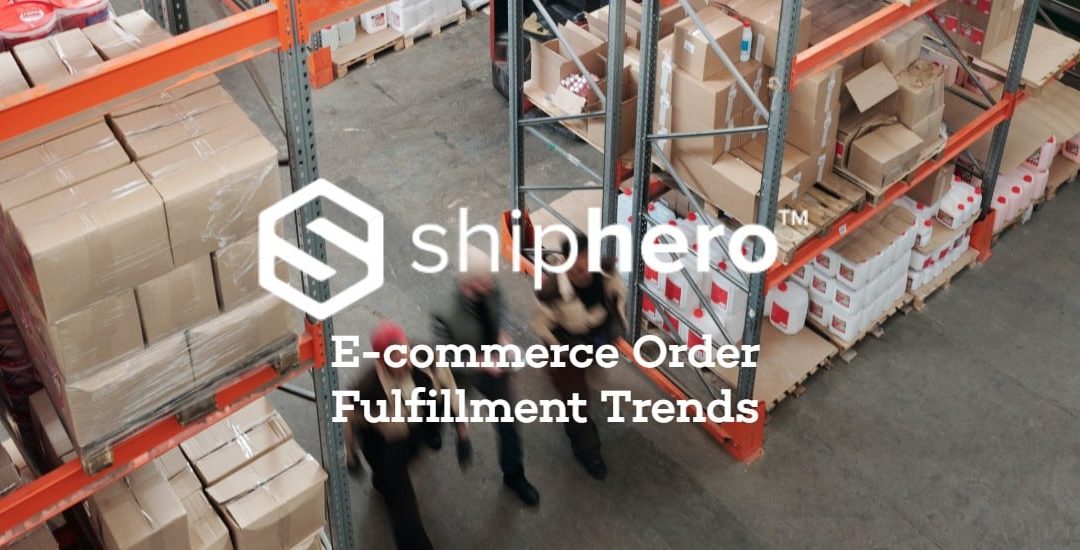
Nov 30, 2020 | Blog, Fulfillment, Warehouse Management Software
ShipHero provides warehouse management software and outsourced ecommerce order fulfillment to over 4,000 brands, processing an annual gross merchandise volume (GMV) of over $5 billion.
In an effort to provide useful data to the DTC community during Covid and the rapid changes occurring in our industry, we are sharing some of the broad segment trends from the products on our platform. Here is the data for the week ended November 30, 2020:
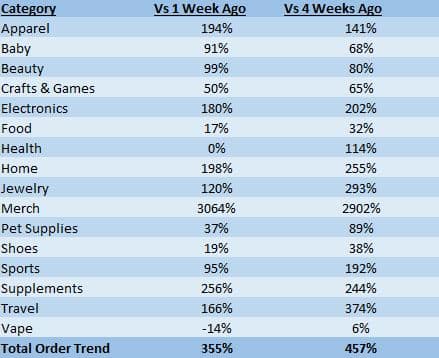
Today is Cyber Monday and the holiday rush is in full swing, as shown by the huge increases in volume over prior weeks. The ShipHero team is on it, helping our customers meet the surging demand.
More charts available on data.shiphero.com.
Do you find this information useful? Let us know! Twitter: @weareshiphero or Email al@shiphero.com.
Dec 1, 2020 | Blog, Fulfillment, Warehouse Management Software
ShipHero Ecommerce Order Fulfillment Update
Tuesday, December 1, 2020
ShipHero just completed another successful Black Friday and Cyber Monday, helping our SaaS and fulfillment customers meet their holiday order rush.
Cyber Monday volume was up 124.14% year-over-year, more than double that of 2019.
For the Black Friday to Cyber Monday period, average order value was up 15.36% year-over-year, increasing to $91.59 from $79.40 a year ago.
Also, during this period, ShipHero total unit volume increased 104.06% year-over-year. The more than doubling of orders is due to the growth new customers using ShipHero as well as sales increases at existing customers.
ShipHero is here to meet your customers’ demand during the holidays and year-round, with fast and accurate ecommerce order fulfillment. See what we can do for you here.
Dec 1, 2020 | Blog, Warehouse Management Software, Warehouse Operations
From the E-Commerce Experts at ShipHero – The Leader in Warehouse Management Software
We hope everyone had a wonderful Thanksgiving and are at least halfway through filtering your email inbox of the BFCM bombardment! Now, here’s a fun fact: around the same time the first Thanksgiving was held in the 17th century, the subscription business model was also first pioneered by publishers of books and periodicals, where travelling salespeople would go door-to-door to convince readers to sign up for continual editions! At the time, this was viewed as a wild derivation from the traditional business model that favored one-off transactions to instead emphasize recurring transactions and payments. Fast forward to today, as brands have progressively searched for ways to improve their holistic shopping experience and nurture relationships with their customers, it seems that they have figuratively taken a page out of these pioneer’s books and forged the rise of the new Subscription Economy.
The Subscription Economy is the term used to describe the trend of otherwise traditional businesses shifting to a subscription business model, where they offer recurring use or access of their product or service, whether monthly, yearly, seasonal or otherwise, rather than the traditional, one-time transaction. A myriad of prestigious companies have successfully employed this business model such as content streaming services like Netflix or Hulu, fitness centers and gyms, software companies like Dropbox, recurring subscription box companies like BirchBox, and more recently, traditional product companies that typically sell goods on a fixed cadence; for example, GNC for vitamins AKA “Subscribe and Save”.
With the recent introduction of Shopify’s Subscription APIs, online e-commerce brands using Shopify can now offer product subscriptions and completely transform how they engage with their customer base. This type of business model typically produces a long-term contract and relationship with a customer, allowing businesses to offer steep discounts for loyal customers that sign up for pre-determined and scheduled purchases.
Let’s briefly list the benefits of the subscription business model and then discuss how your business can make the shift to offer product or service subscriptions.
Benefits of Subscription Models
For reference, some examples of business models that have successfully employed the subscription model include:
- Netflix allowing access to content for a monthly fee
- ButcherBox sending customers a box of meat on a set cadence; customers can subscribe to receive the box every 4, 6 or 8 weeks
- GNC giving a 20% discount on vitamins when signing up for a monthly or 90 day recurring order
- Magazines offering monthly or yearly subscriptions
Brands and businesses that have utilized the subscription business model have reported better customer relationships, better aggregate data, and better diversity in product offerings.
1. Turn Customers in Subscribers
Most large companies report that brand new costumes only generate 15 to 25% percent of their revenues, which means that return customers generate the bulk of the revenue. Focusing on return customers and subscribers allows companies to lower the acquisition costs of targeting a new audience, while also cultivating brand loyalty.
2. Gather More Fruitful Customer Data
As reported by Shopify, modeling and storing subscription data allows merchants to offer benefits like recurring revenue reports on active subscribers, new subscribers, and churned subscribers. This allows your company to better engage with your audience and create targeted content along the customer journey.
Many large brands report developing separate marketing strategies for subscribers and non-subscribers, as well as strategies to convert non-subscribers to subscribers including email campaigns and targeted discounts for subscription and account creation.
3. Sell the Same Product in Multiple Ways
Utilizing the subscription model, a single product could be sold in multiple ways, such as selling the good as a one-time purchase as well as a subscription, including bundles or cross-selling. Bundling, cross-selling and subscriptions gives brands the creative freedom to understand how their customers would prefer to engage with their products and services.
3 Steps to Building a Successful Subscription Model
Once you have decided to build a subscription model for your business, here are three simple steps to get you on your way!
1. Develop a Pricing and Bundle Strategy
When shifting to a subscription business model, subscription pricing and incentives are the most important and complex aspect to consider, because it directly drives the three basic growth strategies: acquire new subscribers, increase engagement and revenue per existing customers, and reduce customer turnover. A fixed subscription price can often be counterproductive because it foregoes the plethora of opportunity for flexible and creative pricing strategies.
Many brands choose to develop pricing strategies according to the factors that matter most to their business. For example, if your business aims to optimize quantity of engagement, customize the pricing to incentivize more usage (e.g., unlimited usage deals). Alternatively, if you want to increase your average order quantity, set subscription pricing that pushes subscribers to order in bulk at a set schedule with discounted prices. Finally, if customer loyalty is your desired result, consider developing reward programs or additional “points” for those that choose to subscribe at checkout.
As you can see, the subscription model offers endless opportunities for flexibility and creativity in customer engagement. There are also freemium options, early bird offers, free trials, bundles and more. Consider your business goals and start with a simple pricing tier, then adjust as you learn from your subscribers what they want!
2. Provide a Way for Customers to Manage Subscriptions
Cultivating strong customer relationships are absolutely essential in the subscription business model. Of course getting new subscribers is important, but in the Subscription Economy the bulk of customer transactions are alterations to active subscriptions like subscription renewals, suspensions, add-ons, upgrades, terminations and more.
As such, brands must provide customers with an intuitive method to manage their accounts throughout the subscription lifecycle. For this reason, Shopify has released a suite of APIs with webhooks to link to your app, thereby giving your subscribers all they need to manage their active subscriptions.
3. Scale with Infrastructure
Successful subscription businesses must rely on their automated processes and enterprise-grade systems to scale their subscription models to provide around-the-clock customer support and business continuity. Subscription-based companies, or those that want to start offering subscriptions, absolutely need seamless integrations with commerce systems, payment gateways, as well as fulfillment and logistics companies.
For that reason, warehouse management software companies like ShipHero integrate directly with Shopify to allow your brand to get as creative as possible with your product and service offerings, all while ensuring the reliable fulfillment capabilities that your customers have come to expect.
Not to mention, creating and shipping customized bundles, kits or bulk orders can get complicated and expensive through traditional fulfillment methods. That’s why ShipHero offers BulkShip: an intuitive interface to design preassembled bundles of products, such as a makeup kit you’d buy at CVS, or a more complex bundle that would get assembled at fulfillment. A good example of this could be a clothing subscription, where the customer selects the sizes, and then the kit is assembled, as Nicholas shows in the video link here.
By offering a subscription service, your brand will most likely be selling a variety of items in a variety of ways, so BulkShip allows brand owners to group orders quickly and pick a lot of the same product at once, making the fulfillment process quick and efficient.
Happy holidays from all of us at ShipHero! And if you like our blogs, be sure to Like & Subscribe 😉
Dec 3, 2020 | Blog, Warehouse Management Software, Warehouse Operations
With the explosion of e-commerce showing no signs of slowing, retailers are increasingly leaning on the technological capabilities and geographic reach of fulfillment providers to place inventories in position for faster last-mile services.
Retailers are placing a greater emphasis on e-commerce versus brick-and-mortar shopping as consumers continue to show hesitancy to shop in stores amid the COVID-19 pandemic. But that emphasis on e-commerce requires positioning inventory closer to the customer in order to shorten the last-mile. As a result, retailers are turning to fulfillment providers with cloud-based technology capabilities to manage their inventories in real-time.
ShipHero CEO Aaron Rubin was asked about the growing trend in ecommerce fulfillment where companies are attempting to place their inventory closer to their customers.
“Retailers will streamline operations, reduce brick-and-mortar presence, and outsource fulfillment to focus on their core service offerings,” Aaron Rubin told JOC.com.
He expects a continued shift from brick-and-mortar dependence to an ecommerce-focused model and noted that many bankrupt retailers with physical stores are relaunching as online retailers and ramping up quickly by utilizing ShipHero’s fulfillment network, which currently consists of seven US warehouses. ShipHero’s warehouse management system software is in 500 warehouses at present.
Read more here at Joc.com. (registration required)

Dec 10, 2020 | Blog, Warehouse Management Software
Aaron Rubin is a longtime veteran of ecommerce. His growing annoyance with the shipping costs related to his business drove him to create ShipHero, a remote company that offers outsourced ecommerce fulfillment services and warehouse management software to other ecommerce businesses.
Recently, more than 1 in every 200 ecommerce packages delivered in America were shipped through ShipHero.
Aaron was interviewed on the Tropical MBA Podcast, discussing how his first ecommerce business nearly went bankrupt, how a need to “scratch his own itch” led to the creation of ShipHero, and offered his take on where the ecommerce industry is headed in the future.
Listen to the podcast here.

Dec 11, 2020 | 3PL Warehouse Management, Blog, Fulfillment, Warehouse Management Software, Warehouse Operations
ShipHero is very proud to announce its partnership with Alloy, a Silicon Valley-based provider of automation solutions for ecommerce. Alloy’s software allows you to automate your store’s marketing, operations, fulfillment, rewards, and much more.
With Alloy, you can easily set up automation to send emails and manage orders, freeing up time for you and your team. Alloy has over 200+ workflows that enable you to improve customer retention and ensure a greater customer experience overall.
Here is a screenshot showing the set up of a ShipHero workflow that triggers events from ShipHero. Data from ShipHero can then be sent to other apps. Users can add logic and conditions for filtering that data.
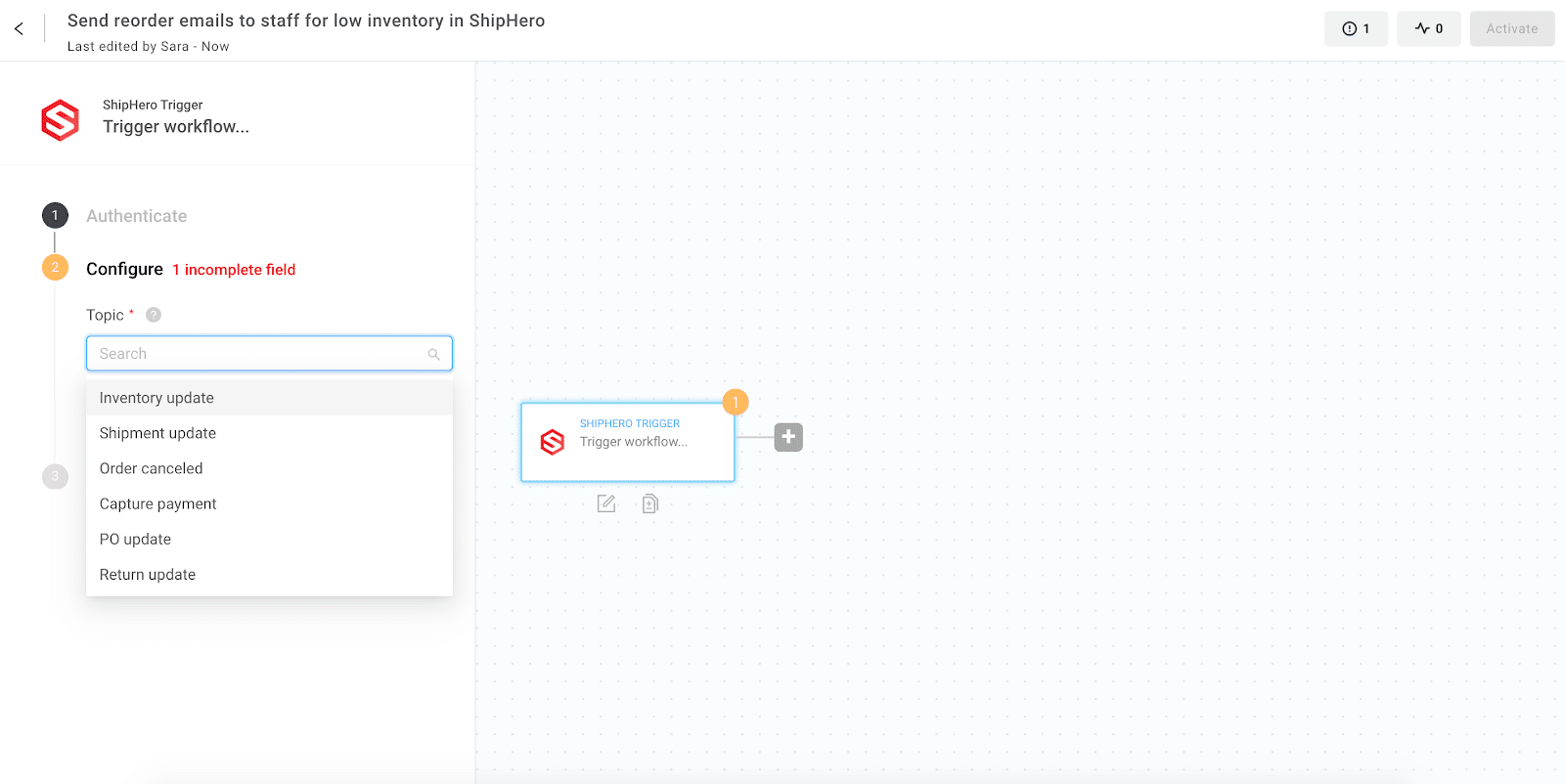
Recipe: Send reorder emails or Slack notifications to staff for low inventory in ShipHero
A great way to organize the flow of customer traffic and inventory is with our workflow.
Our workflow automates reorder emails to be sent to staff when there is low inventory in ShipHero. This ensures that your team can restock inventory at a reasonable pace and without over-stocking.
You can get setup with this workflow immediately by using Alloy’s prebuilt workflow recipe: https://app.runalloy.com/template-setup?id=5fd2801c2f8f2300139725d1
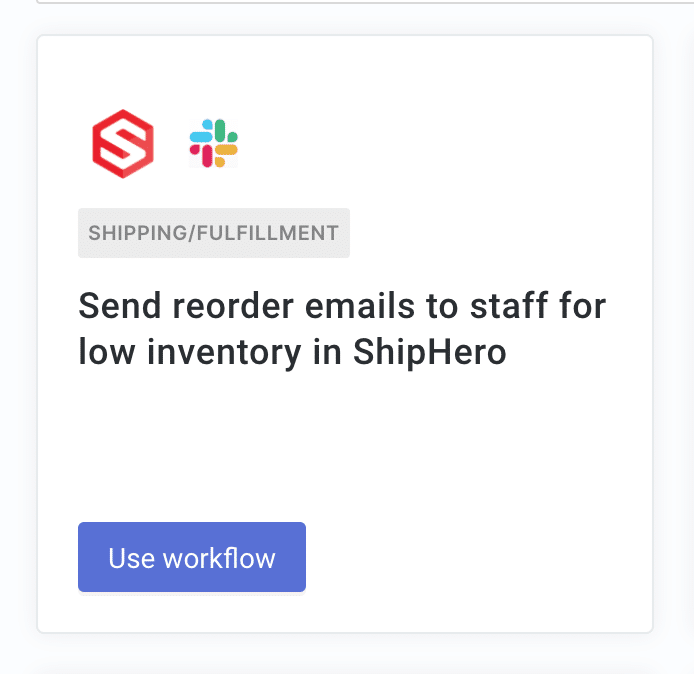
Recipe: Tag Shopify orders based on ShipHero delivery date
Tagging orders is a good way to stay organized especially when your store is expanding globally and there are multiple orders placed on the same day.
This workflow tags Shopify orders based on the ShipHero delivery date. This means that all orders are tagged by date allowing you to view which days are busy and how many orders are expected to ship out weekly.
Apps used: ShipHero, Shopify
Recipe: Set a ShipHero threshold to notify store owner of low inventory
Controlling inventory management can be stressful but with this well-equipped workflow, you can easily be notified of when your inventory is low in ShipHero. For instance, inventory levels are updated regularly and you receive inventory levels for each inventory item. When stock is low, you receive a notification.
Immediate notifications to store owners are key to restocking your inventory and satisfying your eager customers. These notifications can be sent through Slack and email.
Apps used: ShipHero
Recipe: If an order is still unfulfilled in ShipHero after 2 days, email me
Checking the fulfillment status can be time-consuming, especially when multiple orders need to be checked in ShipHero. It’s important to make sure your customers’ orders are sent out on time, but there’s a chance where your product might not be fulfilled by the expected date.
This automation will schedule a workflow after 2 days. Then, it will check to see if the order is unfulfilled for greater than or equal to 2 days. This will trigger an email notification to the store owner.
Apps used: ShipHero
Recipe: Automate fulfillment for Gorgias returns requests in ShipHero
You can automate customer service requests, specifically in shipping and support.
This workflow automates fulfillment for Gorgias return requests in ShipHero.
When a customer requests a return on Shippo, a Gorgias request is immediately created and sent. This frees up time from going back and forth between Shippo and Gorgias and ensures no information is lost.
Apps used: ShipHero, Gorgias
Recipe: Cancel ShipHero scheduled delivery if there is a Gorgias request
Customers will occasionally need to cancel their deliveries. But there’s no easy way for them to cancel a delivery for an order that’s already being fulfilled.
With this automation, customers can send in a support ticket for a cancellation request. Once your team marks it as a canceled order, an email is sent to the ShipHero fulfillment team so they won’t fulfill the order.
Apps used: ShipHero, Gorgias
Recipe: Send ShipHero delivery updates via Klaviyo SMS
SMS messages can have open rates as high as 98% and you’re not limited to using them for promotional campaigns. With this workflow, you can send delivery updates to customers through a text message to leverage higher open and engagement rates.
Here’s how it works: When a fulfillment event happens in ShipHero, a text message reminder is sent via Klaviyo to the customer that their order is out for delivery.
Apps used: ShipHero, Klaviyo
Alloy also has delivery update automations for Omnisend SMS, PostScript, SMSBump, and Tone.
Learn more about Alloy’s ShipHero integration here.
ShipHero is a leading provider of SaaS 3PL software for ecommerce fulfillment.

Dec 16, 2020 | Blog, Fulfillment, Warehouse Management Software
It’s official! Returnly and ShipHero have teamed up, and ShipHero users have access to an exclusive deal. This breakthrough integration allows ShipHero users to offer an end-to-end product return experience. So, what does this mean for ShipHero users?
Automation
Returnly helps Shiphero users create a fully branded, self-serve return center, complete with all the necessary automation and policy controls to reduce operating costs and give customers all the options they want upfront.
Returnly Credit
Mistakes happen. If you ship the wrong order, send the right one immediately and Returnly will accept the risk of the customer actually returning the order. Returnly lets shoppers return or exchange items for a different size, color, or something new without contacting your business.
If a shopper opts for a refund, Returnly offers an instant credit to shop your site while the return is processed. And when you save the sale, Returnly pays for the order so your customer gets the right item before returning the wrong one, completely risk free. This decreases your shipping time and increases the return experience for the customer.
Convert Returns to Repurchases
ShipHero and Returnly seamlessly transfer data to manage and track the return process within ShipHero’s platform. This improved data integration with Returnly makes returns seamless for you and the customer, better positions you to convert returns into repurchases, and saves time and holiday revenue for your business.
Exclusive Offer
To help you successfully navigate the upcoming return season, ShipHero has secured our customers access to an exclusive deal — two months free when you sign-up for a Returnly Premium plan before January 31, 2021.
To learn more and claim your offer, click here.

Dec 28, 2020 | 3PL Warehouse Management, Best Practices, Blog, Warehouse Management Software
Happy Holidays from everyone here at ShipHero! Black Friday has officially kicked off the gift-shopping extravaganza and like you, we’re all scrambling to find that perfect gift for that relative we haven’t seen in-person for the past 10 months… should be easy. (Hint: pajamas). While gift giving was difficult before, with 34% of Americans reporting to return gifts after the holiday season, knowing what to get your friends and family in 2020 is near impossible. So… just make sure to put that receipt in the box.
For retailers, the process of handling product returns, also known as reverse logistics, has always been a messy business, especially after the gift-giving season. According to Shopify, approximately 40% of customers have returned an online purchase in the last 6 months, and 42% of customers report buying a product with full intentions to return some or all of the order in the future. Product returns impact conversion rates, increase costs, and complicate inventory management. So, how can retailers minimize returns, all while making sure that they maintain a good relationship with their customers?
To celebrate our latest partnership with reverse logistic solution company Returnly (and the exclusive holiday deal), Shiphero proudly presents the following the three steps you can take to lower your return rates, improve your customer experience, and in fact develop a competitive advantage through an effective reverse logistics strategy.
Step #1: Offer a Clear and Generous Return Policy
Of course, return rates will drop with a no-refund or strict refund policy, making customers jump through hoops to return your item; however, this will drastically lower your conversion rates at checkout, lower the incentives for new customers to become repeat customers, and ultimately hurt your brand in the long run. Important topics to include in a return policy are:
- Specific products that can’t be returned, like high-ticket items or discounted items
- Additional fees such as restocking fee or shipping
- How long the customer has to return the item
- Conditions for return such as if the receipt is required, or tags, or that it hasn’t been used
- Reimbursement method like cash or store credit, and qualifiers for each method
Behind free shipping, free returns are a huge driver for customers to shop online, and 96% of customers reported that they would shop with a retailer again based on an easy return experience. Many retailers have offset the cost of free returns through increases in price or having customers pay for shipping.
The key takeaway is that your return policy should inspire confidence in your customers to buy from you the first time, and then provide an enjoyable shopping experience (albeit a return) to incentivize them to shop again, and maybe even tell a friend.
The return policy needs to be clear, concise and widely distributed. The policy language should be as easily understood as possible, devoid of legal jargon and fine print. Once set, it should be communicated clearly to both your customers and your employees. In fact, many companies place their return policy in several locations on their landing page and throughout their checkout process, and if it’s generous enough, they advertise it proudly.
And now that Black Friday 2020 has officially kicked off the holiday shopping season, offering a customer-centric return policy will certainly attract more holiday sales, as well as inspire repeat business in the future.
Step #2: Reduce Rates of Return
Simply put, fewer returns means lower costs — with each returned item adding restocking, processing, and possible refurbishing or scrapping fees. So the next thing to focus on is reducing the amount of returns that your company receives
MIT Sloan breaks down returns into two components: controllable returns and uncontrollable returns. Controllable returns are the result of errors or mistakes by the business or customer; as such, each controllable return has an identifiable root cause or causes that can be addressed and mitigated.
For example, the image below lists the most commonly reported causes for returns in 2020, alongside the percentage that they occur.
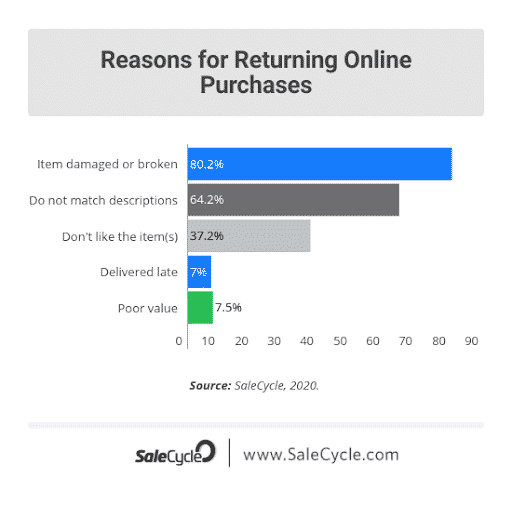
Around 80% of returns were the result of a damaged or broken product, and 7.5% were from a delay in delivery. These are controllable returns showcasing issues with your fulfillment process, which can be addressed through better packaging, better care, or a better third-party fulfillment provider.
Next, we see 64% of returns were the result of a mismatch between product and description. This is also a controllable return highlighting the need for better online product images or descriptions, or an updated sizing chart for clothes and shoes, to more accurately present the product. In fact, many clothing and footwear companies have minimized product returns by employing a “size and fit” specialist, contactable via phone or chat boxes on the company website.
The last controllable return we see making up 7.5% is poor value, which can either be addressed through your manufacturing process or marketing strategy.
The remaining factor is that the customer just didn’t like the product. This is an uncontrollable factor in some respects, in that it could have been a gift or perhaps the customer had a change of heart; but on the other hand, this could even be broken down into smaller factors — some of them controllable. Why didn’t the customer like it?
Finding the answer to the above question is where a well-designed return process needs to come in. Among other things, your company must ensure that all necessary data points are collected throughout the return process in order to further improve your return rates… which brings us to step 3.
Step #3: Optimize Your Return Process
According to MIT Sloan, an efficient reverse logistics strategy has the potential of reducing processing costs by up to 50% or more. For that reason, companies that have a systematic approach to handling returns hold a massive competitive advantage over those companies that treat returns in an ad-hoc way, and major corporations hire departments specifically dedicated to handling returns and optimizing the return process.
At a high level, every return process has the following steps: Receive, Sort, Analyze, Decide, Execute. The retailer receives the returned product, sorts it based on certain factors like reason for return, analyzes its condition, decides what to do with it, then executes on that decision whether it is restocked, refurbished or scrapped.
Make Decisions Upfront
What are your options when you get a return? Creating proper decision trees (IF, THENs) with clear conditions stemming from your return policy gives your company a roadmap to processing returns. This could have many different variations and nuances per your specific business, but as an example it could look like the below:
- IF there’s no issues, THEN restock and process refund
- IF the product is broken AND still fixable THEN refurbish, process refund, and sell through other channels
- IF the product is defective THEN send back to manufacturer for rebate
- IF the product is no longer salvageable THEN scrap
For refurbished products, find other channels to sell your returned items. The loss margins on returns can be minimized through effective and creative measures like selling refurbished goods in other regions or to different markets.
Pretty straightforward but until recently, the return process has been an extremely labor-intensive endeavor, from sorting to analyzing to deciding, thereby requiring loads of labor hours to process just one return. The answer to this sticky situation just so happens to be what an Australian calls his car.
Auto, mate
But seriously, automation is the key. Retailers have found enormous success automating as much of the process as they can, while making the process self-serve for the customer. From the printing of return labels to the issuance of credit, companies that automate the process see large boosts in efficiency and cost-savings. According to Returnly, during a return process, customers expect, at a minimum, to be able to:
- Print labels
- Track their returns
- Know the status of their refund
This may require having a dedicated portal for refunds. And if you’ve made the necessary decisions upfront, these can be automated as well, further reducing your processing costs and allowing your return team to focus on any extenuating circumstances.
Along with automation comes data aggregation. Knowing why your customer returned the product along with other data points can paint a very clear picture on your reverse logistics landscape, allowing your company to address the various pain points and reduce your return rates.
This, among many other reasons, is why ShipHero has partnered with Returnly to automate the return process for any 3PL or retailer using the ShipHero platform, thereby minimizing human touches, improving accuracy, and reducing costs and errors in the return process, all while keeping the merchant updated in real-time.
This leads to faster returns processing time, faster issuance of refunds to the customer, and faster restocking or resale of the returned goods. Everybody wins, mate.
Outsource
Processing returns necessitates much more than a part-time effort. Using a third-party provider to process your returns is a good solution if your company lacks the time, resources or know-how to process returns, or if you have a low amount of returns.
Because some specialize in processing product returns, third-party providers can perform product returns quickly and accurately, often through the use of industry-leading software solutions, thereby lowering costs and increasing revenue.
Also, if your company does not have dedicated personnel or procedures for handling product returns, you consider instituting a third-party to improve the process by delivering state-of-the-art inventory management solutions and data aggregation capabilities.
Conclusion
In summary, to handle the growing impact that returns have on your business, it is important to have a clear and generous return policy that fits your business needs, to consistently find and address the causes for returns, and to optimize your return process through automation or outsourcing.
ShipHero is proud to announce our partnership with Returnly to help empower retailers and 3PLs using the ShipHero platform to take control of their product return process.
And to help you successfully navigate the upcoming return season, we’ve secured our customers access to an exclusive deal — two months free when you sign-up for a Returnly Premium plan before January 31st.
To learn more and claim your offer, click here.
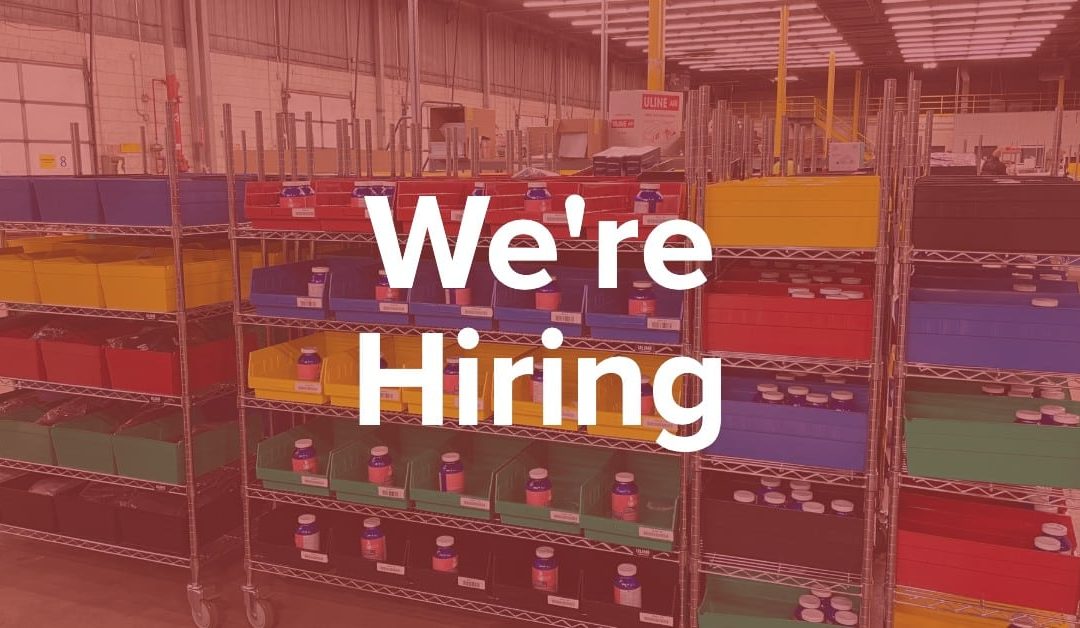
Jan 6, 2021 | 3PL Warehouse Management, Blog, Fulfillment, Warehouse Management Software, Warehouse Operations
“We’re hiring” seems to be hanging from just about every warehouse door these days. With more people sending more packages, third-party logistics (3PL) companies like Amazon and ShipHero must grow to keep up with the soaring ecommerce industry. And now more than ever, we depend on our people to get the job done.
While there has always been a blend of traditional employees and gig workers, like seasonal workers coming in to help with the holiday rush, 3PL companies are now keeping these workers on longer to keep up with the increased shipping volumes from COVID-19.
Pick-and-Packers and fulfillment specialists are in high demand these days. Are you considering joining the growing number of gig workers that are taking on warehouse jobs? If so, let’s take a look at the future of warehouse work, and why more and more 3PL companies are partnering with the Gig Economy.
The Future
As customers have come to expect same-day or two-day delivery, logistics companies and ecommerce fulfillment providers are under pressure to get faster. For that reason, 3PL companies have started increasing the size of their team and investing heavily in people and technology.
There are 400,000 current job openings in US Manufacturing, which is only predicted to increase significantly over the next decade. 3PL companies need to get talent on their team now, or risk getting flogged down with too many orders and not enough people to fulfill them. In order to hire quickly and effectively, 3PL companies are turning to gig workers.
Technology Leads to Trust In the Gig Economy
For 3PL companies and fulfillment providers, the biggest expense is warehouse worker salaries. The next largest expense is investing in the training and tools to attract the best candidates and produce highly effective teams.
For that reason, warehouse jobs are being posted on sites like Indeed, ZipRecruiter, GigSmart, and more, so that the companies can quickly and thoroughly find a candidate pool that’s large enough to fill their demand. Companies can choose the right applicants that match their needs, and oftentimes the platform facilitates payment and provides support for gig workers.
Through advancements in technology and interconnectedness, companies and workers both have reason to trust in the Gig Economy.
Flexible Workforce Management
Hiring gig workers provides flexibility for work schedules, and allows the warehouse manager to only hire for what they need. Flexible workforce management reduces overall cost to the customer, and allows the 3PL company to offer its gig workers more competitive hourly wages. For that reason, warehouse and fulfillment jobs are extremely popular gigs on most job-hunting platforms.
Not only that, gig workers in the logistics industry are often hired for a certain expertise or for seasonal availability. These specialty workers can offer their services for a well-defined scope of work.
It’s More Than a Gig
When you start a warehouse job, what you’re joining is a traditional team of employees as well as some gig workers like you. We engage our temporary workers and regular employees the exact same way, where other industries may treat gig workers like commodities. For that reason, more and more seasonal gig workers are becoming regular employees, because when the gig is up, they feel part of the organization.
Ready to find your side hustle? Whether you’re looking for temporary/seasonal work, or maybe something more long term and fulfilling (excuse the pun), consider a warehouse gig with the local 3PL companies, fulfillment providers or warehouses in your area. Hey, you could even become a ShipHero!
We’re currently building an experienced warehouse team to pick, pack & ship orders in our 150,000 sqft warehouse located in Pennsylvania. You’d be part of a team that helps ship over $5 billion of e-commerce orders a year.
ShipHero is a leading provider of SaaS 3PL software for ecommerce fulfillment.









